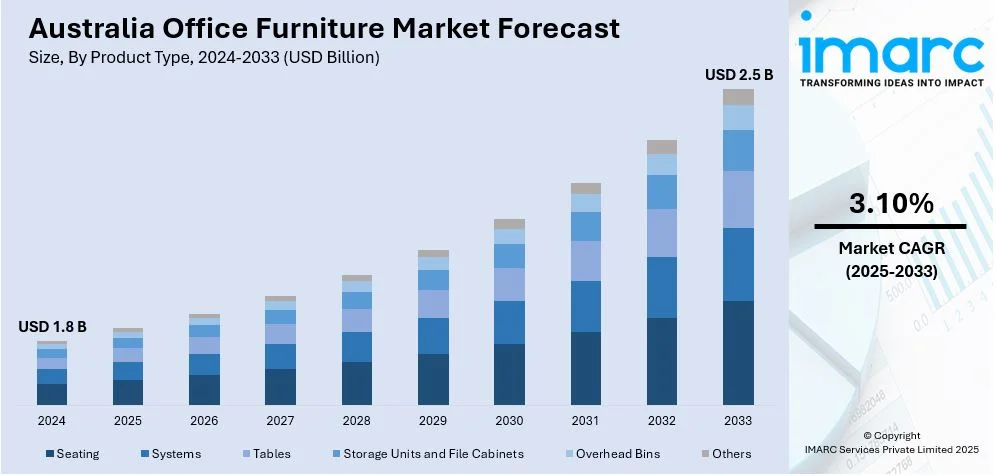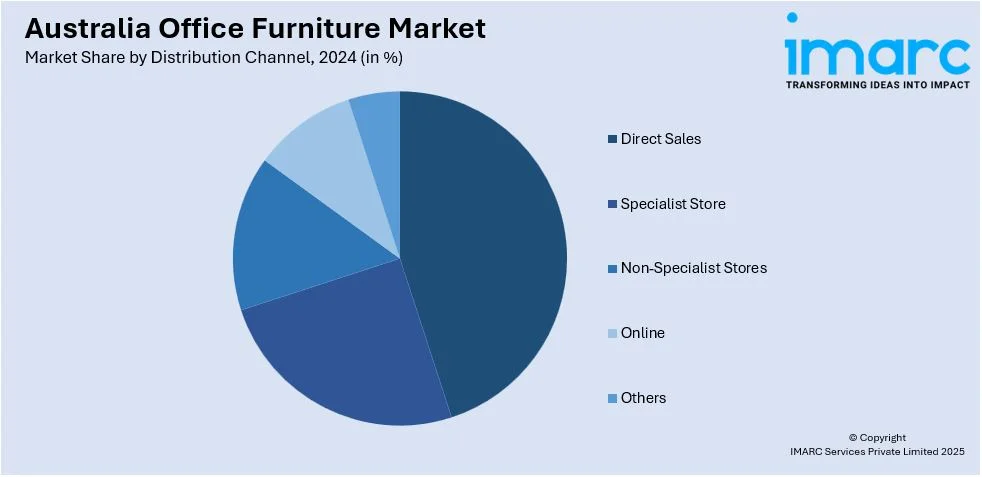
Australia Office Furniture Market Size, Share, Trends and Forecast by Product Type, Material Type, Distribution Channel, Price Range, and Region, 2025-2033
Australia Office Furniture Market Overview:
The Australia office furniture market size reached USD 1.8 Billion in 2024. Looking forward, IMARC Group expects the market to reach USD 2.5 Billion by 2033, exhibiting a growth rate (CAGR) of 3.10% during 2025-2033. The market is driven by increasing demand for ergonomic and hybrid work solutions, sustainability initiatives promoting eco-friendly materials, and rising adoption of smart technology-integrated furniture. Corporate wellness programs, evolving workplace designs, and government policies supporting green procurement influencing purchasing decisions across businesses and institutions thus aiding the market growth.
|
Report Attribute
|
Key Statistics
|
|---|---|
|
Base Year
|
2024
|
|
Forecast Years
|
2025-2033
|
|
Historical Years
|
2019-2024
|
| Market Size in 2024 | USD 1.8 Billion |
| Market Forecast in 2033 | USD 2.5 Billion |
| Market Growth Rate 2025-2033 | 3.10% |
Australia Office Furniture Market Trends:
Sustainable and Eco-Friendly Furniture
The Australia office furniture market is experiencing a shift towards sustainability as businesses increasingly prioritize eco-friendly materials and production methods. With the Australian Furniture Association reporting 8.5 million tonnes of furniture waste annually, the need for sustainable procurement and recycling initiatives is more critical than ever. Firms are stocking furniture made with recycled wood, metal, and biodegradable plastics in the effort to curtail their own carbon footprint, while increased interest in low- volatile organic compounds (VOC) finishes and non-toxic adhesives indicates greater worry about indoor air quality. Government policies and business sustainability efforts further promote sustainable practices, with suppliers becoming certified as FSC and GECA. Producers are embracing circular economy models, providing refurbishing and recycling programs to prolong product lifecycles. This movement towards sustainable office furniture not only promotes environmental objectives but also reflects larger corporate social responsibility (CSR) trends, impacting buying decisions throughout businesses and institutions.

Technology-Integrated Smart Furniture
The growing use of smart office furniture is revolutionizing Australian workplaces, in line with the growth of digital and artificial intelligence (AI)-based office spaces. Businesses are spending money on desks with integrated charging ports, wireless connectivity, and height-adjustable automation to improve convenience and productivity. Smart conference tables with integrated touchscreens and Internet of Things (IoT)-enabled meeting pods are becoming popular in corporate offices, facilitating smooth virtual collaboration. Sensor-enabled office chairs with posture correction capabilities and real-time analytics are gaining traction, enabling health-oriented work cultures. The increasing need for technology-driven solutions that cater to hybrid workspaces and operational effectiveness is the primary driver behind this. With companies modernizing their workplaces, smart furniture is emerging as an essential element of office space future-proofing.
Ergonomic and Hybrid Work Solutions
As more employers adopt hybrid work models, ergonomic office equipment is increasingly gaining momentum in Australia as employers opt to invest in adjustable desks, ergonomic chairs, and modular workstations to maximize workers' welfare and productivity. Implementation of sit-stand desks and flexible seating layouts assists in curbing concerns pertaining to posture and musculoskeletal well-being. Additionally, businesses are integrating home office furniture solutions to support remote work, blurring the lines between office and residential design. Technology-driven solutions, such as smart desks with posture tracking and IoT-enabled adjustments, are enhancing ergonomic efficiency. However, with Australia generating 30,000 tonnes of commercial furniture waste annually, 95% of which ends up in landfills, there is an increasing call for sustainable design, recycling initiatives, and circular economy models to reduce environmental impact and support responsible workplace solutions.
Australia Office Furniture Market Segmentation:
IMARC Group provides an analysis of the key trends in each segment of the market, along with forecasts at the region level for 2025-2033. Our report has categorized the market based on product type, material type, distribution channel, and price range.
Product Type Insights:
- Seating
- Systems
- Tables
- Storage Units and File Cabinets
- Overhead Bins
- Others
The report has provided a detailed breakup and analysis of the market based on the product type. This includes seating, systems, tables, storage units and file cabinets, overhead bins, and others.
Material Type Insights:
- Wood
- Metal
- Plastic and Fiber
- Glass
- Others
A detailed breakup and analysis of the market based on the material type have also been provided in the report. This includes wood, metal, plastic and fiber, glass, and others.
Distribution Channel Insights:

- Direct Sales
- Specialist Store
- Non-Specialist Stores
- Online
- Others
The report has provided a detailed breakup and analysis of the market based on the distribution channel. This includes direct sales, specialist store, non-specialist stores, online, and others.
Price Range Insights:
- Low
- Medium
- High
A detailed breakup and analysis of the market based on the price range have also been provided in the report. This includes low, medium, and high.
Regional Insights:
- Australia Capital Territory & New South Wales
- Victoria & Tasmania
- Queensland
- Northern Territory & Southern Australia
- Western Australia
The report has also provided a comprehensive analysis of all the major regional markets, which include Australia Capital Territory & New South Wales, Victoria & Tasmania, Queensland, Northern Territory & Southern Australia, and Western Australia.
Competitive Landscape:
The market research report has also provided a comprehensive analysis of the competitive landscape. Competitive analysis such as market structure, key player positioning, top winning strategies, competitive dashboard, and company evaluation quadrant has been covered in the report. Also, detailed profiles of all major companies have been provided.
Australia Office Furniture Market News:
- In March 2025, Danny's Desks and Chairs is growing its line of ergonomic office furniture to satisfy increased demand as Australia's market expands from USD 2.01 billion in 2024 to USD 2.89 billion in 2034. As companies focus on workplace comfort and efficiency, the company launches additional ergonomic chairs, sit-stand desks, and flexible workstations to suit changing hybrid and corporate office requirements.
- In February 2024, Value Office Furniture, one of Australia's top wholesale office furniture suppliers, launched a new range of ergonomic office chairs. The fashionable and comfortable chairs use the newest ergonomic technology to improve office spaces, resulting in better comfort and support. The new range is created to address the increasing need for more effective workplace seating.
Australia Office Furniture Market Report Coverage:
| Report Features | Details |
|---|---|
| Base Year of the Analysis | 2024 |
| Historical Period | 2019-2024 |
| Forecast Period | 2025-2033 |
| Units | Billion USD |
| Scope of the Report |
Exploration of Historical Trends and Market Outlook, Industry Catalysts and Challenges, Segment-Wise Historical and Future Market Assessment:
|
| Product Types Covered | Seating, Systems, Tables, Storage Units and File Cabinets, Overhead Bins, Others |
| Material Types Covered | Wood, Metal, Plastic and Fiber, Glass, Others |
| Distribution Channels Covered | Direct Sales, Specialist Store, Non-Specialist Stores, Online, Others |
| Price Ranges Covered | Low, Medium, High |
| Regions Covered | Australia Capital Territory & New South Wales, Victoria & Tasmania, Queensland, Northern Territory & Southern Australia, Western Australia |
| Customization Scope | 10% Free Customization |
| Post-Sale Analyst Support | 10-12 Weeks |
| Delivery Format | PDF and Excel through Email (We can also provide the editable version of the report in PPT/Word format on special request) |
Key Questions Answered in This Report:
- How has the Australia office furniture market performed so far and how will it perform in the coming years?
- What is the breakup of the Australia office furniture market on the basis of product type?
- What is the breakup of the Australia office furniture market on the basis of material type?
- What is the breakup of the Australia office furniture market on the basis of distribution channel?
- What is the breakup of the Australia office furniture market on the basis of price range?
- What is the breakup of the Australia office furniture market on the basis of region?
- What are the various stages in the value chain of the Australia office furniture market?
- What are the key driving factors and challenges in the Australia office furniture?
- What is the structure of the Australia office furniture market and who are the key players?
- What is the degree of competition in the Australia office furniture market?
Key Benefits for Stakeholders:
- IMARC’s industry report offers a comprehensive quantitative analysis of various market segments, historical and current market trends, market forecasts, and dynamics of the Australia office furniture market from 2019-2033.
- The research report provides the latest information on the market drivers, challenges, and opportunities in the Australia office furniture market.
- Porter's five forces analysis assist stakeholders in assessing the impact of new entrants, competitive rivalry, supplier power, buyer power, and the threat of substitution. It helps stakeholders to analyze the level of competition within the Australia office furniture industry and its attractiveness.
- Competitive landscape allows stakeholders to understand their competitive environment and provides an insight into the current positions of key players in the market.
Need more help?
- Speak to our experienced analysts for insights on the current market scenarios.
- Include additional segments and countries to customize the report as per your requirement.
- Gain an unparalleled competitive advantage in your domain by understanding how to utilize the report and positively impacting your operations and revenue.
- For further assistance, please connect with our analysts.
 Inquire Before Buying
Inquire Before Buying
 Speak to an Analyst
Speak to an Analyst
 Request Brochure
Request Brochure
 Request Customization
Request Customization




.webp)




.webp)












